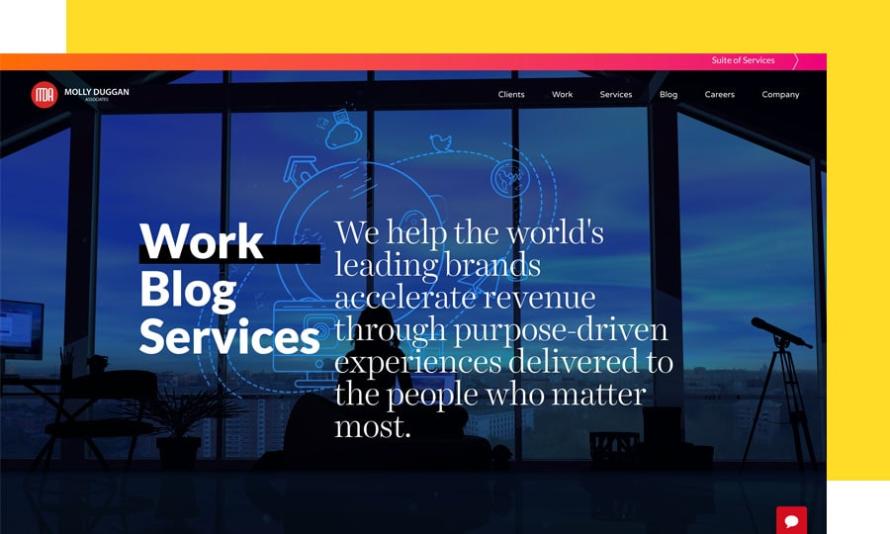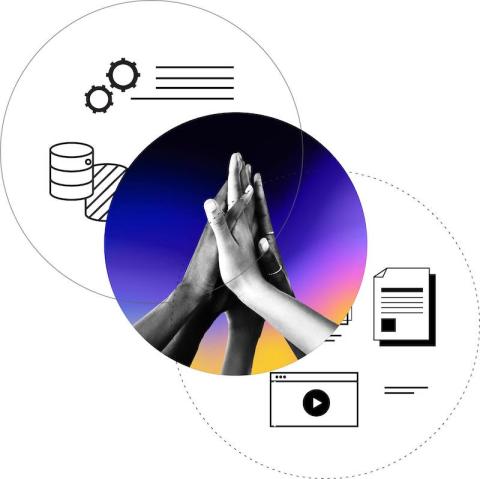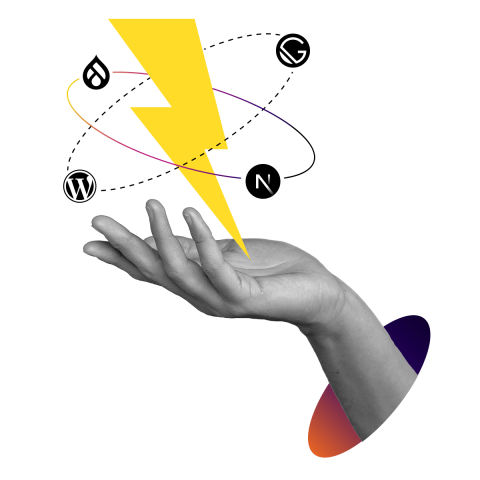Delivering Purpose-Driven Decoupled Experiences with Molly Duggan
Image

Pantheon Strategic Partner, Molly Duggan, is a multi-disciplined creative technology agency focused on delivering purpose-driven experiences to the people who matter most.
A key participant in the Early Access program for Pantheon’s Front-End Sites, Founder and CEO Molly Duggan and CTO Erik Cochran sat down with us to share their experience.
Image

Why did Molly Duggan choose to build a decoupled practice?
Cochran: We've been working with Decoupled CMS since 2008. Before Pantheon offered the Early Access program for decoupled applications, we built the front end of the application on Heroku. Heroku was similar to Pantheon in supporting Git integration and different multidev environments where you have your Dev, Test, Live. It's very configurable, but it's for anything and everything. Heroku isn’t focused solely on Drupal and WordPress like Pantheon is. Pantheon’s core focus on these CMSs is core to the many reasons we chose Pantheon. Almost all of our clients are on WordPress or Drupal.
Because we focus primarily on Drupal and WordPress, we don’t need the whole hardware store; we need a few tools — and Pantheon delivers just that.
Erik Cochran, CTO at Molly Dugan
Duggan: Pantheon helped us bridge the gap between the different functions in development and marketing. Pantheon made it easier for our marketing clients to own their complete MarTech stack.
What do you like about Pantheon's decoupled solution?
Cochran: When working on a decoupled project, whether Drupal or WordPress paired with Gatsby, VueJS or ReactJS, Pantheon allows us to help our clients collaborate across functions and iterate faster. Pantheon provides a complete solution for the next-gen, high-demand web development environment that serves everyone on the team. Pantheon’s WebOps methodology is a complete solution that considers all of this.
Duggan: We’re always looking at all possible solutions. When we identify a solution, we examine what’s going to increase productivity and what’s going to deliver measurable and impactful results for site owners. A decoupled CMS architecture can deliver best-in-class user experiences, increased productivity, and measurable results. While a decoupled CMS offers several benefits, there are also situations where it may not be the best option for an organization.
Can you give us an example of when a decoupled solution might not be the best choice for a client?
Duggan: Before we start, we ask important questions, like what are you trying to accomplish? What pain points are you trying to solve? How will we deliver a better customer experience? How fast does the project need to be done? When appropriate, a decoupled approach empowers teams to collaborate and deliver results. Putting the back-end CMS and the front-end framework under one umbrella helps teams get the tools they need to integrate and work faster and more efficiently.
Decoupling works exceptionally well when collaborative teams aren’t siloed. When administrators can see the sites in one place, content editors can get the best CMS tools, and developers can work in their preferred frameworks and languages, it’s an ideal way for teams to work.
Molly Duggan, CEO at Molly Duggan
Cochran: A decoupled CMS may not be the best option if an organization has limited resources for front-end development. Another situation where a decoupled CMS may not be the best option is if an organization has a simple website. The benefits of a decoupled CMS, such as scalability and integration with other systems, may not be necessary for an organization with a small number of pages and minimal interactive features.
When does a decoupled solution work best?
Duggan: Decoupling works exceptionally well when collaborative teams aren’t siloed. When administrators can see the sites in one place, content editors can get the best CMS tools, and developers can work in their preferred frameworks and languages, it’s an ideal way for teams to work.
Unlike in a typical build, all visitors and content managers hit the same WordPress and Drupal sites. When teams work in a decoupled environment, both developers and content managers update the back-end site, which is then published to the front end. This approach provides better security because we reduce access to WordPress or Drupal and improve performance and speed. Now visitors only query the front-end server for static files instead of dynamically loaded pages. The site renders statically and ultra-fast. This provides flexibility in how we build our front and back-end code bases. Front-end code can be reused, and we can reorganize and componentize everything. Issues are isolated between the front-end and back-end.
Typically, the best use cases for decoupled applications include SaaS and big media websites that might have multiple content authors and custom-integrated advertising. So sites with thousands or tens of thousands visitors per day. Decoupled applications are ideal for revenue-generating websites rather than marketing websites.
The beauty of decoupled applications is that they are fast, stable, scalable, and secure, which helps to create a better user experience and a better experience builds trust in the brand.
Molly Duggan, CEO at Molly Duggan
Which decoupled client projects are you most proud of?
Cochran: That would be our most recent decoupled project for the Structural Building Components Association (SBCA) an international trade association.
SBCA originally built an application for a select group of members and most recently, they wanted to expand the service/application to its entire membership. The site was built on Drupal 7. As part of expanding and creating an API, we determined it was appropriate to create a decoupled application to add flexibility and improve the user experience for SBCA’s members — enabling SBCA’s customers to do what they need to do quickly.
While the web application currently lives on Drupal 7, we rely on a separate server to generate custom PDFs with integrated customization during the PDF output, which needs a deeper integration to the server (Java). That’s problematic because now we’re depending on two different services that are not under the same umbrella — GoDaddy and Pantheon. Ideally, we want everything in one environment for better security, updates, and management. We’re relying on a server like GoDaddy for now because the customer already has a GoDaddy account and the whole setup is there. So now we have the headless front end, rebuilt the PDF generator (previously built with Java) with Node to sit next to the ReactJS project. Our backend is powered by Drupal 9, which we upgraded from Drupal 7. We solved multiple problems by adding resources into a single platform — Pantheon.
Why did you choose the build on Pantheon Front-End Sites?
Duggan: My focus is finding the perfect blend between technology and humanity. So to find that balance, I keep my finger on surfacing trends and emerging technologies to help shape the agency’s strategic direction and evolve our clients’ brands.
In 2011, Pantheon was one of those emerging platforms. We partnered with Pantheon since the beginning, and it was clear then that Pantheon was evolving in a synchronous direction with our agency. And more than a decade later, the relationship with Pantheon is still integral to our agency’s strategic direction.
I also am hands-on day-to-day and work directly with clients to iterate the brand experience and drive growth across all brand touchpoints — so for nearly 100% of our clients, that work includes turning our clients’ website into their most sophisticated business application — which is why we embrace the WebOps methodology. When brands can design excellent experiences that deliver on the customer’s purpose, that creates this trust.
Cochran: I’m proud of the relationships we’ve built with Pantheon since 2011.
With the SBCA project, we leaned on our partnership with Pantheon even more…Pantheon adjusted their parameters and helped us adjust our application to work perfectly on the platform…I don’t know if they’d do that for anyone and I’d like to think our long-term partnership was in our favor.
Erik Cochran, CTO at Molly Dugan
With the SBCA project, we leaned on our partnership with Pantheon even more. Originally, the early access program for decoupled sites was for Gatsby and VueJS. Since we were already underway with our project using ReactJS, we asked if we could use an alternative JavaScript framework. The supportive team at Pantheon adjusted their parameters and helped us adjust our application to work perfectly on the platform. I don’t know if they’d do that for anyone and I’d like to think our long-term partnership was in our favor. The team at Pantheon has been supportive of this project and of hundreds of applications and websites we’ve worked on. They rock!
Lastly, what sets your team apart from other creative tech agencies?
Duggan: As an agency, we're focused on client sustainability and productivity. Our clients rely on us for four main goals: increasing brand equity, growing revenue more efficiently, generating a more qualified pipeline and delivering better engagement and customer experiences. We help organizations develop human-centric digital ecosystems intended to constantly inspire their customers along the buying journey. We blend new, innovative approaches with proven best practices.
Our team is unique in that we are the only agency that uses WebOps support as a service offering for our clients. We encompass everything into WebOps, including marketing technology integrations. WebOps brings together developers, designers, marketers, content editors, and more. With WebOps culture, everyone who is responsible for changing the website in significant ways such as code, visuals, content, success measurements,thinks of themselves as one cross-functional team, iterating towards the same goals.
With WebOps culture, everyone who is responsible for changing the website in significant ways such as code, visuals, content, success measurements — thinks of themselves as one cross-functional team, iterating towards the same goals.
Molly Duggan, CEO at Molly Duggan

